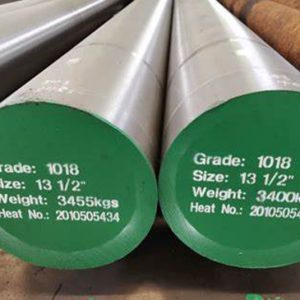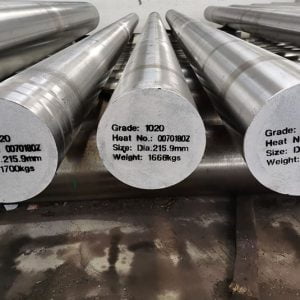Introduction
AISI 1018 is a widely used carbon steel known for its excellent machinability, weldability, and ductility. It is often used in applications that require high precision and smooth surface finishes. This comprehensive guide aims to provide engineers with a detailed understanding of AISI 1018, including its properties, applications, and benefits. By the end of this guide, you’ll have a thorough knowledge of why AISI 1018 is a preferred choice in various industries.
What is AISI 1018?

Composition and Characteristics
AISI 1018 is a low-carbon steel alloy that is known for its balance of strength, ductility, and hardness. The chemical composition of AISI 1018 makes it an ideal choice for a variety of applications where these properties are required.
- Carbon Content: 0.15-0.20%
- Manganese: 0.60-0.90%
- Phosphorus: Max 0.04%
- Sulfur: Max 0.05%
These elements give AISI 1018 its characteristic properties, such as excellent machinability and weldability.
Mechanical Properties
Understanding the mechanical properties of AISI 1018 is crucial for engineers when selecting materials for specific applications. Here are the key mechanical properties:
- Tensile Strength: 440 MPa
- Yield Strength: 370 MPa
- Elongation: 15-20%
- Hardness (Brinell): 126
These properties highlight the versatility and reliability of AISI 1018 in various engineering applications.
Table: Chemical Composition and Mechanical Properties of AISI 1018
| Property | Value |
|---|---|
| Carbon Content | 0.15-0.20% |
| Manganese | 0.60-0.90% |
| Phosphorus | Max 0.04% |
| Sulfur | Max 0.05% |
| Tensile Strength | 440 MPa |
| Yield Strength | 370 MPa |
| Elongation | 15-20% |
| Hardness (Brinell) | 126 |
Applications of AISI 1018
Automotive Industry
AISI 1018 is extensively used in the automotive industry due to its excellent machinability and weldability. It is commonly found in parts such as:
- Shafts: For their strength and machinability.
- Gears: Due to their durability and wear resistance.
- Pins: For their strength and ease of fabrication.
Construction Industry
In the construction industry, AISI 1018 is favored for its strength and ease of welding. It is used in:
- Structural Components: For their load-bearing capacity.
- Fasteners: Due to their strength and ductility.
- Rails and Pipes: For their durability and machinability.
Manufacturing Industry
AISI 1018 is a popular choice in manufacturing due to its balance of strength and ductility, making it suitable for:
- Machinery Parts: For their durability and precision.
- Tooling Components: Due to their machinability and wear resistance.
- Fixtures and Jigs: For their strength and ease of fabrication.
Other Applications
Beyond the automotive, construction, and manufacturing industries, AISI 1018 is also used in:
- Home Appliances: For components requiring strength and smooth finishes.
- Furniture: In parts requiring ductility and weldability.
- Electrical Appliances: Due to its machinability and durability.
Benefits of Using AISI 1018
Excellent Machinability
AISI 1018 is known for its excellent machinability, making it an ideal choice for components requiring high precision and smooth surface finishes. This property allows for faster production times and reduced tool wear, leading to cost savings in manufacturing processes.
- High Precision: Achieves tight tolerances and smooth finishes.
- Reduced Tool Wear: Lowers maintenance costs and downtime.
Superior Weldability
The weldability of AISI 1018 is another significant advantage, allowing for strong and reliable welds. This makes it suitable for a wide range of applications, including those requiring complex welding techniques.
- Strong Welds: Ensures durability and reliability.
- Versatility: Suitable for various welding methods.
High Ductility
AISI 1018’s high ductility allows it to be easily formed and shaped without cracking or breaking. This property is essential for applications requiring intricate shapes and bends.
- Ease of Forming: Allows for complex shapes and designs.
- Prevents Cracking: Ensures structural integrity.
Cost-Effectiveness
Compared to other steels with similar properties, AISI 1018 is relatively affordable, providing excellent value for money. Its balance of properties makes it a cost-effective choice for many engineering applications.
- Affordable: Lower material costs.
- Value for Money: High performance at a reasonable price.
Heat Treatment and Surface Hardening
Heat Treatment Processes
Heat treatment processes are used to enhance the mechanical properties of AISI 1018. Common heat treatment methods include:
- Annealing: Softens the steel and improves machinability.
- Quenching and Tempering: Increases hardness and strength.
- Normalizing: Refines the grain structure and improves toughness.
Surface Hardening Techniques
Surface hardening techniques are employed to increase the surface hardness of AISI 1018 while maintaining its ductility and toughness. These techniques include:
- Case Hardening: Enhances surface hardness and wear resistance.
- Induction Hardening: Provides a hard surface layer with a tough core.
- Carburizing: Increases carbon content at the surface for improved hardness.
Comparison with Other Steels

AISI 1018 vs. AISI 1045
AISI 1018 and AISI 1045 are both carbon steels, but they have different properties and applications:
- AISI 1018: Lower carbon content, better machinability, and weldability.
- AISI 1045: Higher carbon content, greater strength, and hardness.
AISI 1018 vs. AISI 1020
AISI 1018 and AISI 1020 are similar, but AISI 1020 has slightly higher carbon content:
- AISI 1018: Better machinability and slightly lower strength.
- AISI 1020: Higher strength and hardness, but less machinable.
AISI 1018 vs. Stainless Steels
AISI 1018 is often compared to stainless steels due to their different properties and uses:
- AISI 1018: Lower cost, excellent machinability, good weldability.
- Stainless Steels: Higher corrosion resistance, higher cost, lower machinability.
Conclusion
AISI steel 1018 is a versatile and reliable carbon steel widely used in various engineering applications. Its excellent machinability, superior weldability, high ductility, and cost-effectiveness make it a preferred choice for engineers. Understanding the properties and benefits of AISI steel 1018 allows for informed decisions when selecting materials for specific projects.
FAQ
What is Steel 1018?
Steel 1018, also known as AISI 1018, is a low-carbon steel alloy known for its excellent machinability, weldability, and ductility. It is widely used in various industries for its balanced mechanical properties and ease of fabrication.
What are the key properties of Steel 1018?
Steel 1018 has several key properties, including a tensile strength of 440 MPa, yield strength of 370 MPa, elongation of 15-20%, and a Brinell hardness of 126. These properties make it suitable for a wide range of applications.
What are the common uses of Steel 1018?
Steel 1018 is commonly used in the automotive, construction, and manufacturing industries. It is utilized in the production of shafts, gears, pins, structural components, fasteners, and machinery parts due to its excellent machinability and weldability.
How is Steel 1018 heat treated?
Steel 1018 can undergo various heat treatment processes to enhance its mechanical properties. Common methods include annealing, quenching and tempering, and normalizing. These processes improve the steel’s hardness, strength, and toughness.
Can Steel 1018 be welded easily?
Yes, Steel 1018 is highly weldable. Its low carbon content reduces the risk of weld cracking, making it suitable for various welding techniques. This property ensures strong and reliable welds in different applications.
How does Steel 1018 compare to other low-carbon steels?
Steel 1018 offers better machinability and weldability compared to higher carbon steels like 1045. While it has lower strength and hardness, its balanced properties and affordability make it a popular choice for many applications.
What is the composition of Steel 1018?
Steel 1018 typically contains 0.15-0.20% carbon, 0.60-0.90% manganese, and trace amounts of phosphorus and sulfur. This composition provides a good balance of strength, ductility, and machinability.
What industries benefit from using Steel 1018?
Industries that benefit from using Steel 1018 include automotive, construction, and manufacturing. It is also used in home appliances, furniture, and electrical appliances due to its versatile properties and ease of fabrication.
What are the advantages of using Steel 1018 in manufacturing?
The advantages of using Steel 1018 in manufacturing include its excellent machinability, which allows for precise and smooth surface finishes, and its weldability, which ensures strong and durable welds. Its cost-effectiveness also makes it an attractive option for various applications.
What surface hardening techniques are applicable to Steel 1018?
Surface hardening techniques for Steel 1018 include case hardening, induction hardening, and carburizing. These methods increase the surface hardness of the steel while maintaining its ductility and toughness, enhancing its wear resistance and durability.





